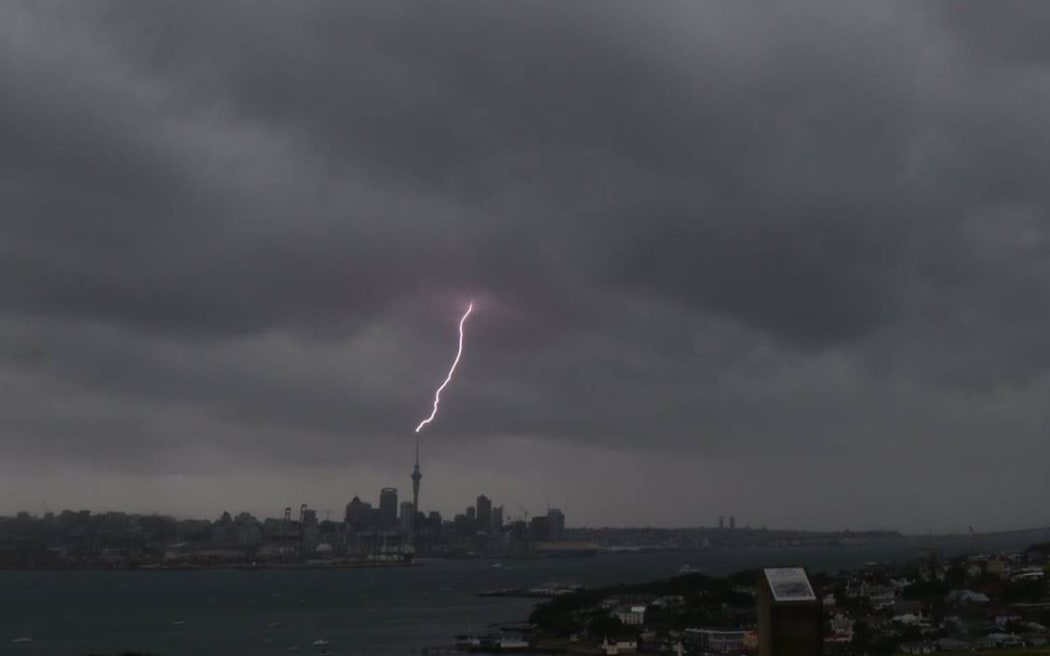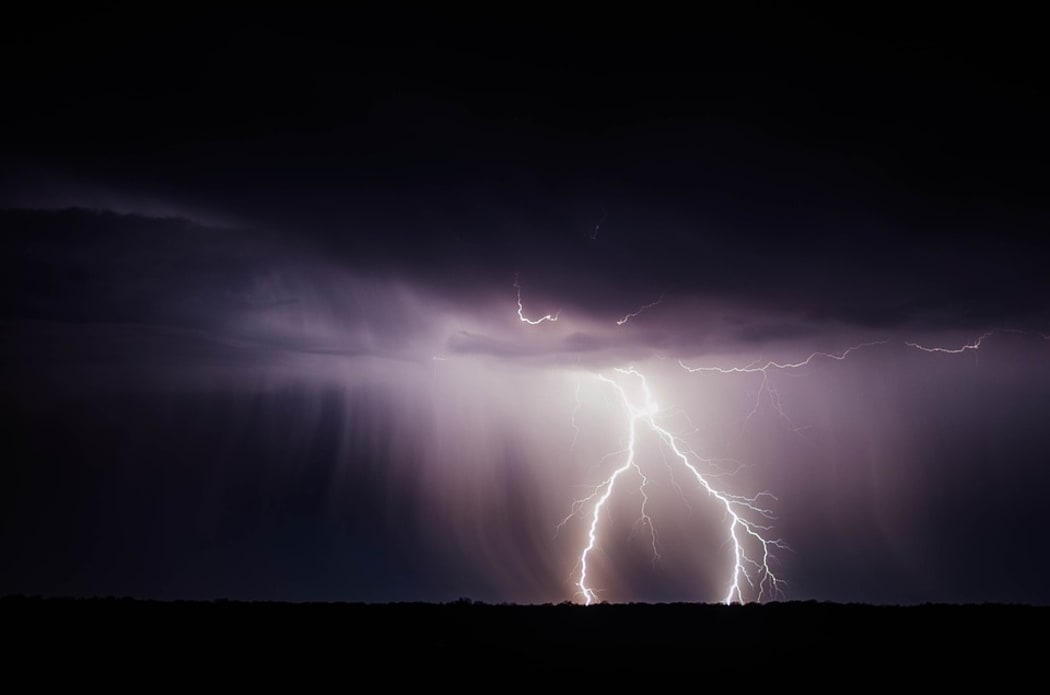What is lightning, where does it come from, and what should you do in the middle of a lightning storm? NIWA meteorologist Chris Brandolino joins us to answer all these questions, and more.

Auckland's Sky Tower was hit by lightning just before midday today. Photo: Facebook / North Shore Weather
Hundreds of lightning strikes hit the North Island on Tuesday, injuring four people and killing four cows in Hamilton.
With more thunderstorms expected on Thursday, Brandolino explains the underlying science to Afternoons' Jesse Mulligan and offers some tips on staying safe.
What is lightning?
"Lightning basically is electricity - think of it like static electricity," he says.
"Rub your feet on the carpet on a dry day and you get zapped when you touch something, or if you're going down a slide at the playground … you touch metal, you feel static electricity.
"In a very simple way that is lightning ... you have ice crystals, you have water droplets up in the clouds, and when they rub against one another [they] create static electricity.
Why does lightning strike the ground?
"When that difference between what's happening in the cloud and the surface of the ground becomes great enough, you get basically a lightning bolt," Brandolino says.
He says when lightning hits the earth, what happens first is an invisible bolt called a "stepped leader" creates a path of least resistance.

Photo: creative commons - pixabay - Free-Photos
"Then the lightning actually goes from the ground back up to the cloud: that is what you see."
That's the case with cloud-to-ground lightning but, he says, there's several different kinds of lightning.
"I think less than half of the lightning strikes actually make it to the ground when you look at the long-term average: most of it is within the cloud - cloud-to-cloud or cloud-to-air lightning."
What causes thunderstorms?
"Generally speaking, what you need for thunderstorms to form, you need heat," Brandolino says.
"If the air above us is significantly colder than say the air at the ground, that air will rise really fast - and when you get those violent rising columns of air you're gonna see those puffy cumulonimbus clouds.
"[If] you see the pretty cotton balls in the sky, those are fair weather clouds - fair weather cumulus - but when you get cauliflower [cumulonimbus] that's violently rising air.
"You can even get that in the winter except it's probably not that warm out, but relative to the air above the ground … you get the same effect."
What are dry thunderstorms?
That means there can also be dry thunderstorms - without rain.
"Maybe not so much in New Zealand but in more continental places," Brandolino says.
"The rain, it never really makes it to the ground - the air is so stinkin' dry - but what you do get is the electrical discharge, the lightning."
How hot is lightning?
"Lightning, as I alluded to is quite hot - it can be up to five times hotter than the sun, so it can reach temperatures of roughly 27,000, 28,000 degrees celsius.
"That's why you'll see burn marks on the ground - or it'll cause fires oftentimes."
How to not be thunderstruck
"Air is a really poor conductor of electricity, and lightning is lazy," Brandolino says.
"It goes for the tallest object out there. If you're in an open field - like the rugby field like we saw, or if you're out in the water, you are going to be the tallest thing out there, odds are. That increases your odds of being struck by lightning.
"Stay indoors, and when you are indoors stay away from windows.

Lightning flash over a multi-storey building in Molesworth St, Wellington. Photo: SUPPLIED / Thomas, from Wellington
"Back in the day before cellphones weren't around I used to visit schools - I'd always say 'don't use the phone … the landline'.
"You don't want to take a bath or be in a shower."
More lightning on the way?
He says on Thursday there's likely to be another front coming through the North Island.
"That's the leading edge to some colder [air].
"Oftentimes cold fronts, what they can do is help to accelerate or enhance that naturally rising air because of that structure: warm below, cold above. If you get a front, that can be a catalyst to kind of add a little bit of juice.
He says that could well mean more lightning and thunder and at least some heavier rain, but that's likely to clear up by the weekend.
"Probably a good weekend ... we deserve one.
"A little bit cool and breezy but at least dry - for much of the North Island and much of the country for that matter."

